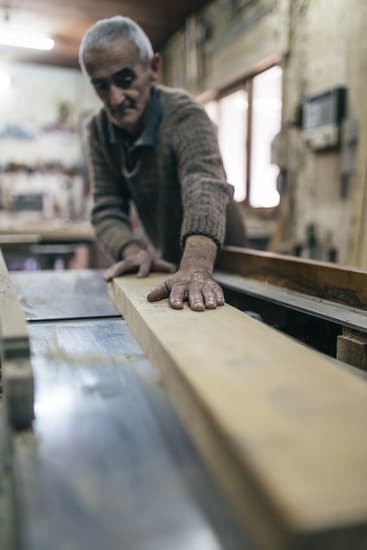When embarking on a painting project, it’s essential to consider the proper order in which to tackle the task. In this article, we will delve into the age-old question: should I paint walls or woodwork first? Understanding this key aspect of painting can greatly impact the overall success and appearance of your final result.
Before diving into the specifics of painting order, it is crucial to emphasize the importance of preparing surfaces before applying any paint. This applies not only to walls but also to woodwork. Properly preparing surfaces ensures better adhesion of the paint and enhances its durability, resulting in a longer-lasting finish.
As you weigh your options on whether to start with walls or woodwork, it’s vital to consider several factors that may influence your decision. Factors such as the size of your project, time constraints, and personal preferences all play a role in determining the most suitable approach. By thoroughly evaluating your specific needs and considering these factors, you can make an informed decision that will yield optimal results.
In the following sections of this article, we will explore both sides of the debate by outlining the pros and cons of painting walls first versus woodwork first. We’ll also provide insights from experienced professional painters and offer a step-by-step guide for achieving a flawless finish regardless of which option you choose. By considering all these elements, you’ll be empowered to make an educated decision on the best painting order for your particular project.
Importance of preparing surfaces before painting
One of the most crucial steps in any painting project is preparing the surfaces before applying the paint. This step is important for both walls and woodwork, as it ensures a smooth and even finish. By properly preparing the surfaces, you can enhance the overall durability and longevity of your paint job.
Surface Cleanliness and Smoothness
Before diving into any painting project, it is essential to clean and smoothen the surfaces that you plan to paint. Dust, dirt, grease, and other debris can prevent the paint from adhering properly, resulting in a patchy finish. Additionally, rough or uneven surfaces can make it difficult to achieve a smooth and professional-looking outcome.
To ensure cleanliness, start by thoroughly cleaning the walls or woodwork with warm soapy water or a mild cleaner. Remove any loose peeling paint or old wallpaper if necessary. After cleaning, use sandpaper or sanding blocks to smoothen any rough areas or imperfections on the surface. This step will not only improve adhesion but also help you achieve a polished look once the paint is applied.
Surface Priming
Another crucial aspect of surface preparation is priming. Primers create an adhesive layer between the surface and the paint, allowing for better coverage and improved adherence. Priming helps to seal porous surfaces such as bare wood or drywall, preventing excessive absorption of paint and ensuring its even distribution.
When working on walls or woodwork, consider using a primer that matches your desired topcoat type (oil-based or latex). Applying primer not only enhances your final result but also boosts your paint’s durability over time.
Overall, proper surface preparation is vital for achieving a professional-looking finish on both walls and woodwork. By ensuring cleanliness and smoothness while utilizing primers where necessary, you can lay a strong foundation for your painting project’s success. Take time to thoroughly prepare your surfaces before painting to ensure optimal results.
Factors to consider
When deciding whether to paint walls or woodwork first, it is important to consider the specific needs of your project. Several factors should be taken into account to ensure the best outcome for your painting project.
One factor to consider is the condition of the surfaces you will be painting. If both the walls and woodwork are in good condition and require minimal repairs or touch-ups, you may have more flexibility in determining which to tackle first. However, if there are significant imperfections such as cracks, holes, or uneven surfaces, it may be beneficial to prioritize these repairs before painting either the walls or woodwork.
Another factor to consider is the type of paint you will be using. Different types of paint have different drying times, which can affect the order in which you paint. For example, if you are using oil-based paint for your woodwork and latex paint for your walls, it may be necessary to start with the woodwork first as oil-based paint generally takes longer to dry.
Additionally, consider the layout and design of your space. If there are intricate details on your woodwork that require precise cutting-in, it may be easier to complete this step before painting the walls. On the other hand, if you are planning on using different colors for your walls and woodwork, painting one first may help prevent any accidental splatters or smudges on already painted surfaces.
To assess these factors effectively, create a checklist outlining your project needs and priorities. This list can include considerations such as surface condition, paint types and drying times, intricate details on woodwork, desired color scheme, and timeline requirements. By carefully evaluating these factors and referring back to your checklist throughout the decision-making process, you can make an informed decision on whether to paint walls or woodwork first that best suits your specific project needs.
Pros and cons of painting walls first
Painting the walls before tackling the woodwork can have both advantages and disadvantages, and it is important to consider how this order of painting can affect the overall outcome of your project.
One of the main benefits of painting the walls first is that it allows for easier color coordination. By starting with a fresh coat of paint on the walls, you can easily choose a color that complements or contrasts with the woodwork. This can help create a cohesive and visually pleasing look in your space. Additionally, painting the walls first allows for easier touch-ups if any drips or mistakes occur while painting the woodwork.
However, one downside of painting the walls first is that it increases the risk of accidentally getting paint on freshly painted surfaces when working on the woodwork. Even with careful techniques, there is always a chance of drips or splatters occurring during the painting process. This means that extra precautions need to be taken to protect your newly painted walls from potential damage.
Another factor to consider is that painting the walls first may require more time and effort when it comes to masking off areas and protecting them from accidental paint splatters or smudges. It requires careful attention to detail and precision to ensure clean lines between where the walls meet the woodwork.
| Pros | Cons |
|---|---|
| Easier color coordination | Risk of accidental paint on woodwork |
| Easier touch-ups on walls | Requires more time and effort for masking |
Pros and cons of painting woodwork first
When it comes to painting a room, one common debate is whether to paint the walls or woodwork first. In this section, we will examine the pros and cons of painting woodwork first, allowing readers to better understand the advantages and disadvantages of this approach.
One advantage of painting woodwork first is that it allows for greater precision and attention to detail. By tackling the woodwork before moving on to the walls, you can focus solely on achieving a flawless finish on these smaller surfaces. This can be particularly important if your woodwork has intricate details or architectural features that require careful brushwork. Additionally, painting the woodwork first can help protect it from accidental drips or splatters that may occur when painting the walls.
However, there are also some potential downsides to painting woodwork first. One disadvantage is that it can be more time-consuming and require additional effort. If you’re working with multiple windows, doors, baseboards, and other types of woodwork in a room, you’ll need to carefully tape off these areas before starting on the walls.
This extra step can add significant time to your project timeline. Additionally, if you decide to make any changes or touch-ups to your wall color after completing the woodwork, it may be more challenging to achieve a seamless finish.
Expert recommendations
Importance of seeking advice from professional painters
When it comes to painting the walls or woodwork in your home, it can be difficult to determine the best approach. That’s why seeking insights from professional painters is crucial. These experts have years of experience and knowledge in the industry, making them valuable resources for understanding the proper painting order. By considering their recommendations, you can ensure that your project will yield optimal results.
Considerations for different project needs
Professional painters emphasize that there is no one-size-fits-all answer when it comes to deciding whether to paint walls or woodwork first. They emphasize the importance of assessing your specific project needs and taking into account factors such as the condition of your walls and woodwork, the type of paint being used, and any repairs or priming that may be necessary.
For example, if you are working with newly installed woodwork, professionals often recommend painting the walls first to avoid getting any wall paint on the freshly finished woodwork. On the other hand, if you have existing woodwork that requires extensive repair and priming before painting, starting with the woodwork might be a more efficient choice.
The general consensus: Paint walls first
While individual circumstances may vary, many professional painters tend to lean towards painting walls first as a general rule of thumb. The primary reason for this recommendation is that ceiling splatters or accidental drips from wall paint are relatively easy to rectify when painting woodwork later on. However, addressing any marks or damage on newly painted walls caused by stray paint from woodwork can be more challenging and time-consuming.
These professionals also highlight another advantage of painting walls first: it allows for a smoother transition between colors when working on intricate details like baseboards or trim. By starting with a clean canvas on the walls, you have more flexibility in achieving seamless lines and avoiding color bleed onto the woodwork.
In the next section, we will explore a step-by-step guide that outlines best practices for painting either walls or woodwork first. Following these expert recommendations can help ensure a successful and satisfactory painting project.
Step-by-step guide
Painting a room can be a daunting task, especially when trying to determine the best order in which to paint the walls and woodwork. To help you achieve a flawless finish, it is essential to follow proper painting order. In this step-by-step guide, we will outline the best practices for deciding whether to paint walls or woodwork first.
- Assess the condition of your walls and woodwork: Before beginning any painting project, it is crucial to assess the condition of both your walls and woodwork. Determine if any repairs or preparation work needs to be done, such as filling in holes or sanding rough surfaces. Addressing these issues prior to painting will ensure a smooth and even finish.
- Consider the type of paint being used: Different types of paint have different drying times. If you are using oil-based paint for your woodwork and latex-based paint for your walls (which is most common), it is generally recommended to start with the woodwork first.
This is because oil-based paints tend to have longer drying times, so by starting with the woodwork, you can allow ample time for it to dry before moving on to the walls. - Prioritize protecting surfaces: Regardless of which surface you choose to paint first, it is crucial to protect surrounding areas from any potential spills or splatters. Use painter’s tape along edges where the two surfaces meet and cover furniture or flooring with drop cloths or plastic sheets.
- Painting walls first: If you decide to begin with painting the walls, start by cutting-in around edges with a brush before using a roller for larger areas. This allows for better control and precision when working near trim or corners. Once the walls are completely dry, use painter’s tape to protect them before moving on to painting the woodwork.
- Painting woodwork first: When starting with painting the woodwork, use a small angled brush for more precise application along edges and corners. Apply two to three thin coats, allowing ample drying time between each coat. Once the woodwork is completely dry, use painter’s tape to protect it before painting the walls.
By following these step-by-step practices, you can achieve professional-looking results when painting your walls or woodwork. Just remember to assess surface conditions, consider drying times of different paint types, prioritize protecting surrounding areas, and follow proper techniques for each surface. Ultimately, the decision of whether to paint walls or woodwork first will depend on your specific project needs and preferences.
Final thoughts
As you consider whether to paint walls or woodwork first, it is important to evaluate your specific project needs. Each approach has its own advantages and disadvantages, so it ultimately comes down to personal preference and the condition of your surfaces.
If you are looking for a seamless finish and have well-maintained woodwork, painting the walls first may be the better option. By starting with the walls, you can easily touch up any accidental splatters or smudges from painting the woodwork. This can save you time and effort in the long run. However, if you have older or damaged woodwork that requires repairs or special attention, it may be more beneficial to paint the woodwork first.
On the other hand, if you want to prioritize precision and detail on your woodwork, painting it first allows for greater control over brush strokes and achieving a flawless finish. This approach can also minimize the risk of accidentally getting wall paint on your newly painted woodwork. However, keep in mind that this method requires more care during wall painting to avoid damaging the freshly painted woodwork.
In order to make an informed decision, consult with professional painters who can provide valuable insights based on their experience. They can assess your specific project requirements and recommend a suitable painting order based on factors such as surface condition, type of paint being used, and any repairs or preparation needed.
Ultimately, choosing whether to paint walls or woodwork first depends on your unique circumstances. Keep in mind that proper preparation of surfaces is crucial regardless of which approach you choose. Ensure that surfaces are clean, smooth, and properly primed before applying any paint to achieve optimal results.
To further guide you in making this decision:
- Consider enlisting professional help for complex projects or if you are unsure about the best course of action.
- Take into account your timeline and budget constraints when determining which surfaces to prioritize.
- Use high-quality paint and tools to enhance the durability and longevity of your paint job.
- Take before and after photos to document your progress and assist with touch-ups or future projects.
Remember, the painting order you choose should ultimately suit your needs and allow you to achieve a beautiful finish that enhances the aesthetics of your space.
Bonus tips
Achieving a flawless paint job goes beyond just deciding whether to paint walls or woodwork first. To further enhance the overall outcome of your project, there are some bonus tips and suggestions that can make a significant difference.
- Use high-quality tools and materials: Investing in quality brushes, rollers, and paints can greatly contribute to achieving a flawless finish. Cheap brushes may leave bristles on the surface or create streaks, while low-quality paints may not provide good coverage or durability.
- Properly prepare the surfaces: Before applying any paint, it’s crucial to properly prepare the walls and woodwork. This includes cleaning the surfaces to remove dirt, dust, and grease, sanding away imperfections, filling in cracks or holes with putty or caulk, and priming if necessary. By taking the time to prepare the surfaces adequately, you ensure that the paint adheres well and provides a smooth finish.
- Use painter’s tape: To achieve clean and crisp lines between different surfaces or color areas, use painter’s tape to mask off edges. Ensure that the tape is properly applied and pressed down firmly to prevent any bleeding of paint underneath. Remember to remove the tape at an angle while the paint is still wet for best results.
- Apply thin coats of paint: It’s better to apply several thin coats of paint rather than one thick coat. Thin coats dry faster and are less likely to drip or show brush marks. Allow each coat to fully dry before applying another layer for optimal results.
- Maintain consistency in painting direction: Whether you’re painting walls or woodwork, try to maintain consistency in your painting direction for a more uniform look. This means using long strokes from top to bottom or side to side rather than randomly changing directions.
By following these bonus tips along with considering whether to start with painting walls or woodwork first, you can significantly improve the outcome of your painting project. Remember that attention to detail, proper preparation, and using high-quality materials are key factors in achieving a flawless result. Happy painting.
Conclusion
In conclusion, the decision of whether to paint walls or woodwork first ultimately depends on several factors and project needs. It is crucial to assess the specific requirements of your painting project before making a decision. Understanding the pros and cons of painting walls first and painting woodwork first can help you achieve the desired outcome.
While some experts recommend painting walls first as it allows for easier coverage and reduces the risk of drips or spills on newly painted woodwork, others argue that painting woodwork first provides a better foundation for clean lines and crisp edges. Ultimately, it is important to consider your skill level, timeline, and personal preferences when deciding on the order of painting.
Professional painters often emphasize the importance of proper surface preparation before any painting begins. This includes cleaning, sanding, and priming surfaces to ensure optimal adhesion and long-lasting results. Taking these steps will help you achieve a flawless paint job regardless of whether you choose to paint walls or woodwork first.
Frequently Asked Questions
Do professionals paint trim or walls first?
When it comes to painting, professionals typically paint the trim before the walls. The reason behind this order is that painting the trim first allows for greater precision and control.
By painting the trim first, professionals can ensure that they achieve clean lines and avoid accidentally getting paint on the walls. Additionally, if there are any drips or accidental smudges during the process of painting the trim, it is much easier to touch up those areas on unfinished walls than on freshly painted ones.
What is the correct order to paint a room?
The correct order to paint a room involves several steps. First, it is important to prepare the room by moving furniture and protecting surfaces with drop cloths or plastic sheets. Next, any necessary repairs or priming should be done before starting to paint. Once preparations are complete, professionals usually start by cutting in the edges using a brush to create clean lines along corners, ceilings, baseboards, and other areas where a roller cannot reach easily.
After cutting in, they will use a roller to apply paint onto the main areas of the walls. It is recommended to work from top to bottom and from one side of the wall to another in smooth strokes for an even finish. Finally, once the walls are completely dry, any necessary touch-ups can be done.
When should I paint my baseboards?
Baseboards should generally be painted after preparing and painting the surrounding walls but before any flooring installation takes place. Painting baseboards earlier than this may risk accidental damage or scuffs during subsequent painting processes or construction activities in the room. Before starting to paint baseboards, it is essential to thoroughly clean them and remove any dust or grime that may affect adhesion or result in an uneven finish.
Applying painter’s tape along adjacent surfaces like walls and flooring can help achieve precise lines while avoiding unwanted smudges as well. By waiting until after-wall painting and prior to flooring installation to paint baseboards, you can ensure that they blend seamlessly with both elements while minimizing potential damage.

Hi everyone! I’m a woodworker and blogger, and this is my woodworking blog. In my blog, I share tips and tricks for woodworkers of all skill levels, as well as project ideas that you can try yourself.





